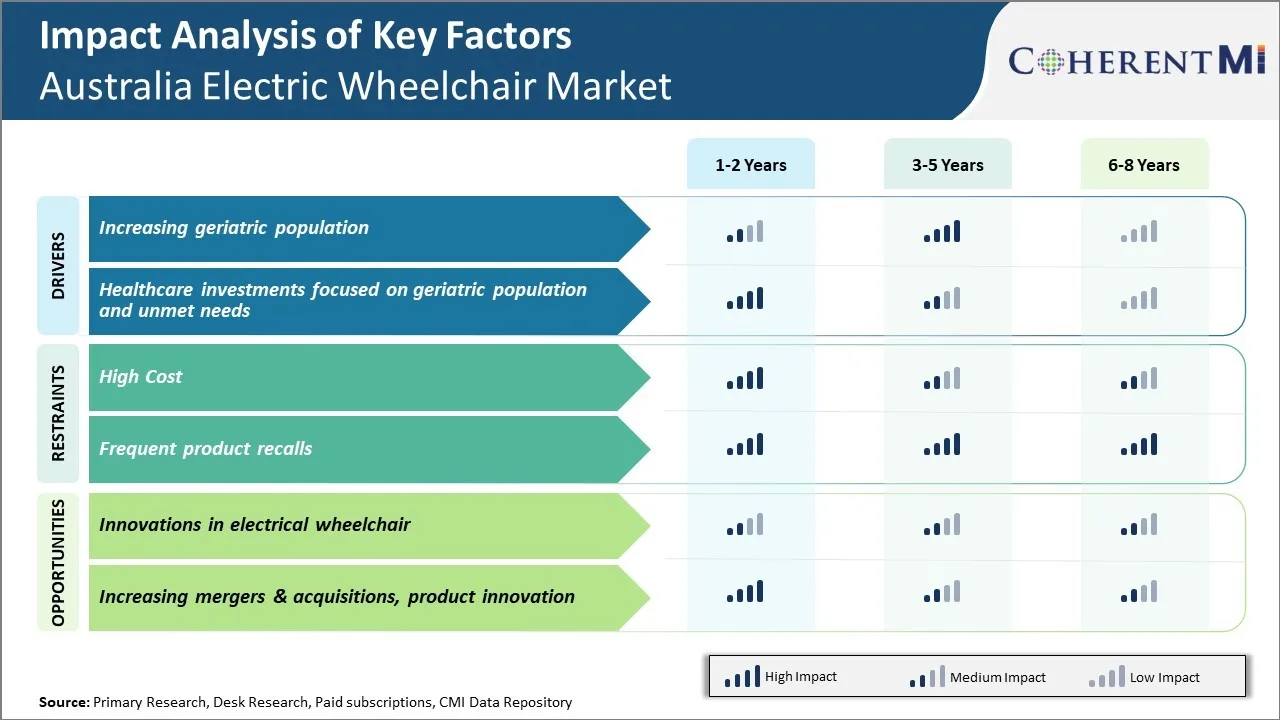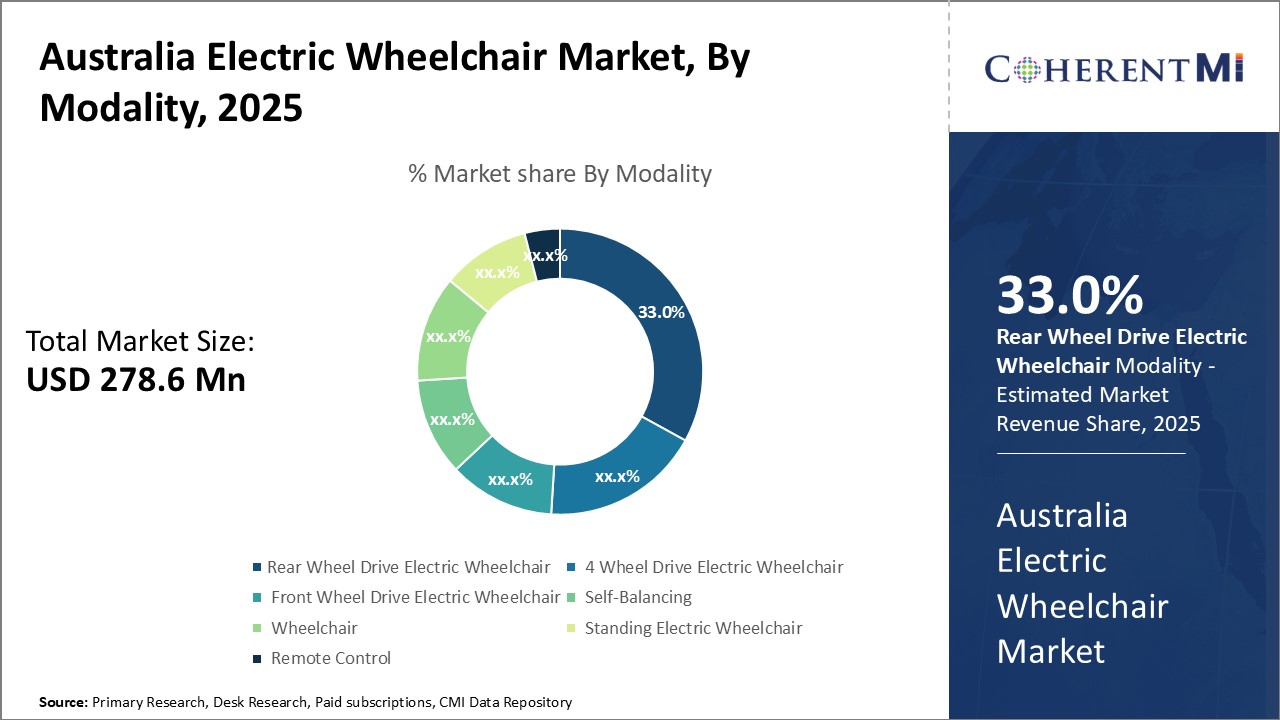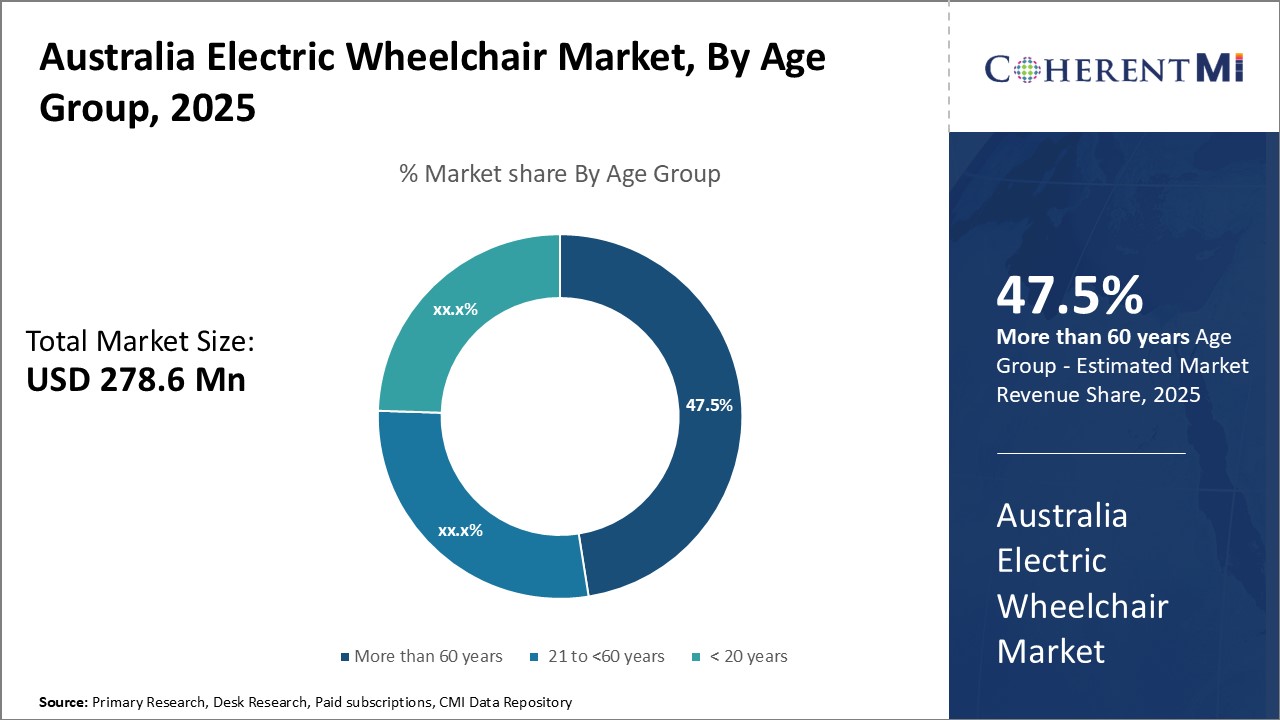Australia Electric Wheelchair Market Size - Analysis
The Australia Electric Wheelchair Market is estimated to be valued at USD 278.6 Mn 2025 and is expected to reach USD 529.2 Mn by 2032, growing at a compound annual growth rate (CAGR) of 9.4% from 2025 to 2032.
Market Size in USD Mn
CAGR9.6%
| Study Period | 2025-2032 |
| Base Year of Estimation | 2024 |
| CAGR | 9.6% |
| Market Concentration | High |
| Major Players | SUNRISE MEDICAL (US) LLC, Invacare Corporation, KYMCO Healthcare, MEYRA GmbH, Invacare Corporation and Among Others |
please let us know !
Australia Electric Wheelchair Market Trends
The growing geriatric population is a major driver propelling the electric wheelchair market in Australia. According to Australian Bureau of Statistics, the proportion of people aged 65 years and over is projected to rise from 15% currently to between 20-23% of the total population by 2066. The unprecedented growth in the aging segment of the population will significantly contribute to the increase in demand for mobility assistance products like electric wheelchairs.
The aging population in Australia is driving significant growth in the electric wheelchair market. As per the Australian Bureau of Statistics, the proportion of people aged 65 and over is expected to grow from 15% currently to more than 22% by 2058. This will significantly increase the number of older people who require mobility assistance. At the same time, the prevalence of age-related disabilities like arthritis, osteoporosis and joint problems is also rising in the geriatric population.

Market Challenge – Frequent Product Recalls
For example, in 2022, Australia's Therapeutic Goods Administration (TGA) issued a recall of 185 units of a popular electric wheelchair model citing significant issues with the battery packs that could result in overheating and potential fires. Similarly, in 2021, another 150 units of a different brand of powered wheelchairs were recalled owing to faults in the wiring harness which increased the risk of sudden loss of power and accidents during use. These high-profile mass recalls understandably scared many potential consumers and raised doubts about the reliability and safety standards of electric powered wheelchairs.
Electric wheelchairs have become increasingly popular assistive devices for mobility in Australia. Recent innovations in the technology present a promising opportunity for growth in the electric wheelchair market here. With an aging population and rising rates of disability, the need for wheelchairs is projected to rise substantially in the coming years. Advanced electric wheelchairs that are lighter, more durable, and offer greater customization and functionality could help meet this growing demand.
Additional built-in technologies are enhancing comfort, safety and accessibility. Modern electric wheelchairs come equipped with innovative features like integrated scale functions to monitor weight changes, precision driving controls, crash sensors, and Bluetooth connectivity capabilities.
Segmental Analysis of Australia Electric Wheelchair Market
 Insights, By Modality: Rear Wheel Drive Electric Wheelchairs Sub-segment Contribute The Highest Share
Insights, By Modality: Rear Wheel Drive Electric Wheelchairs Sub-segment Contribute The Highest ShareIn terms of modality, rear wheel drive electric wheelchairs contribute the highest share of 33% in the Australia electric wheelchair market, owing to their ease of use and maneuverability. Rear wheel drive models offer users greater control as they allow for precise steering through the rear wheels. This is beneficial for indoor as well as outdoor navigation where users need to maneuver in tight spaces or corners. As Australia's elderly population grows significantly, there is increasing need for mobility devices that can be operated independently indoors.

The highest share of the Australia electric wheelchair market is captured by users over 60 years of age with a market share of 47.5%. As life expectancy increases in Australia, the percentage of persons over 60 is growing rapidly. This older demographic faces highest prevalence of mobility issues due to age-related disabilities, health conditions or limited ambulation. Electric wheelchairs have emerged as a vital assistive device for preserving their independence and quality of life.
Competitive overview of Australia Electric Wheelchair Market
The major players operating in the Australia Electric Wheelchair Market include SUNRISE MEDICAL (US) LLC, KYMCO Healthcare, Invacare Corporation, Invacare Corporation, MEYRA GmbH, Permobil Inc., and Levo AG.
Australia Electric Wheelchair Market Leaders
- SUNRISE MEDICAL (US) LLC
- Invacare Corporation
- KYMCO Healthcare
- MEYRA GmbH
- Invacare Corporation
Australia Electric Wheelchair Market - Competitive Rivalry

Australia Electric Wheelchair Market
(Dominated by major players)
(Highly competitive with lots of players.)
Australia Electric Wheelchair Market Segmentation
- By Modality
- Rear Wheel Drive Electric Wheelchair
- 4 Wheel Drive Electric Wheelchair
- Front Wheel Drive Electric Wheelchair
- Self-Balancing Wheelchair
- Standing Electric Wheelchair
- Remote Control
- By Age Group
- More than 60 years
- 21 to <60 years
- < 20 years
- By End User
- Consumer
- Care

Would you like to explore the option of buying individual sections of this report?
Manisha Vibhute is a consultant with over 5 years of experience in market research and consulting. With a strong understanding of market dynamics, Manisha assists clients in developing effective market access strategies. She helps medical device companies navigate pricing, reimbursement, and regulatory pathways to ensure successful product launches.
Frequently Asked Questions :
How big is the Australia Electric Wheelchair Market?
The Australia Electric Wheelchair Market is estimated to be valued at USD 278.6 in 2025 and is expected to reach USD 529.2 Million by 2032.
Which are the major players operating in the Australia Electric Wheelchair Market?
SUNRISE MEDICAL (US) LLC, KYMCO Healthcare, Invacare Corporation, Invacare Corporation, MEYRA GmbH, Permobil Inc., and Levo AG are the major players.
Which is the leading Modality in the Australia Electric Wheelchair Market?
The leading Modality segment is Rear Wheel Drive Electric Wheelchair.
What are the major factors driving the Australia Electric Wheelchair Market growth?
The increasing geriatric population and healthcare investments focused on geriatric population and unmet needs are the major factors driving the Australia Electric Wheelchair Market.
What are the key factors hampering the growth of the Australia Electric Wheelchair Market?
The high cost and frequent product recalls are the major factors hampering the growth of the Australia Electric Wheelchair Market.